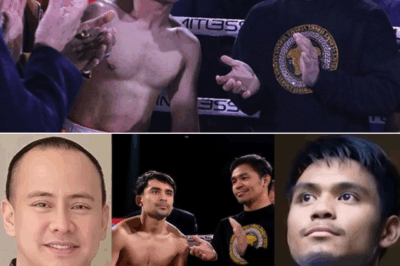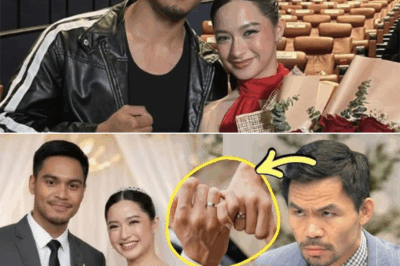It was a quiet afternoon at the cemetery, the sky draped in gray as if mirroring the heaviness in everyone’s hearts. The 40th day after Nora Aunor’s passing had brought together all of her children: Lotlot, Ian, Matet, Kenneth, and Kiko. It wasn’t just a day to mourn; it was a day of reckoning, of unspoken truths, and of moments that had been long buried — just like the one Kenneth carried in his pocket.
As they stood around their mother’s grave, sharing prayers and silent glances, Kenneth quietly stepped beside Ian. With a slight hesitation, he pulled out an old, weathered photograph. He didn’t say anything — he simply handed it over.

Ian looked down and stared at the image for a few seconds before his expression shifted. A flicker of recognition. A memory resurfacing. The photo was from decades ago — Nora, much younger, sitting on a wooden bench outside a modest house. But it wasn’t just her. In the photo were all the children, some barely toddlers. And standing at the edge, almost cut off from the frame, was Lotlot — her hand on her mother’s shoulder, her eyes distant even then.
Lotlot, curious, walked over. When she saw the photograph, something within her broke open.
She didn’t speak. She didn’t need to. The tears welled up instantly and fell silently down her cheeks.
It wasn’t just the image that moved her — it was what it represented. That photo had been taken on a day she had almost forgotten: a birthday celebration that ended in heartbreak, when she had felt most left out, most unloved. She had always remembered that day differently — fractured, incomplete. And yet, here it was, frozen in time. Proof that she had been there. That her presence mattered, even if it hadn’t felt that way.
For years, Lotlot had struggled with her relationship with Nora. Despite the public image of a close-knit family, those closest to them knew that things hadn’t always been easy. There were gaps — emotional, personal, even physical. Adoption, identity, longing — all played a part in shaping the complex bond between mother and daughter.
And now, in the stillness of the cemetery, with a single photograph, that entire story came rushing back. Kenneth gently placed a hand on her shoulder. Ian, who had remained silent, finally spoke, “I didn’t even know this photo still existed.”
“No one did,” Kenneth replied. “I found it in one of her old boxes. It was wrapped in tissue… like she wanted to protect it.”
That detail struck them all. Nora, the superstar, the icon — had chosen to preserve this fragile image, hiding it away from the public eye but keeping it safe. It was a message, unspoken but deeply felt. Perhaps, in her own quiet way, she had tried to hold onto the moments that mattered most — even if she couldn’t always express it.
The photograph was later placed inside a small envelope and tucked into the bouquet of white lilies they laid on Nora’s grave. It wasn’t just a tribute; it was a reconciliation. A symbol that not all wounds had to remain open. That even in the absence of answers, healing could begin.
And so, what started as a solemn visit ended with something much more profound — a connection rediscovered, not through grand gestures, but through a single, silent tear.
News
Dr. Vicki Belo at Hayden Kho Nagbigay ng Bonggang Suporta kay Eman Bacosa: Mamahaling Gamit, Regalo, at Isang Di-Malilimutang Araw
Sa gitna ng mga batikos, tanong, at diskusyong umiikot kay Eman Bacosa Pacquiao nitong mga nakaraang linggo, bigla namang nagbago…
Asawa ng Kambal ni Jinkee Nagsalita: Totoo Ba Talagang Pinababayaan ni Manny Pacquiao ang Anak na si Eman?
Matapos pumutok ang mga komento at batikos online tungkol umano sa “kawalan ng suporta” ni Manny Pacquiao sa anak niyang…
Umuugong na Pagbaliktad: PBBM Pinipigilang Bumagsak Habang Mambabatas at Retired Generals Humaharap at Kumakastigo sa Katiwalian
Sa gitna ng mainit na protesta at lumalakas na panawagang sugpuin ang katiwalian sa pamahalaan, biglang sumirit ang tensyon sa…
Hindi Pinayagang Mag-Travel? Holiday Trip ni Sen. Jinggoy Estrada, Binabara Habang Papalapit ang Posibleng Warrant of Arrest
Sa gitna ng papalapit na Kapaskuhan, isang bagong kontrobersya na naman ang sumabog matapos lumutang ang ulat na nagpaplano umanong…
Viral na Singsing ni Jillian Ward: Simbolo ng Pagkakaibigan o Simula ng Seryosong Relasyon kay Eman Pacquiao?
Sa nakaraang linggo, muling pinag-usapan ng publiko ang tambalang Jillian Ward at Eman Pacquiao matapos mapansin ng mga netizens ang…
Eman Pacquiao, Inamin ang Pagkaka-admire kay Jillian Ward: Pagkakaibigan o Simula ng Pag-ibig? Ang Kontrobersiya sa Showbiz at Social Media
Sa mundo ng showbiz, bihira ang mga kuwento na nagdudulot ng matinding diskusyon sa publiko—at isa na dito ang rebelasyon…
End of content
No more pages to load












